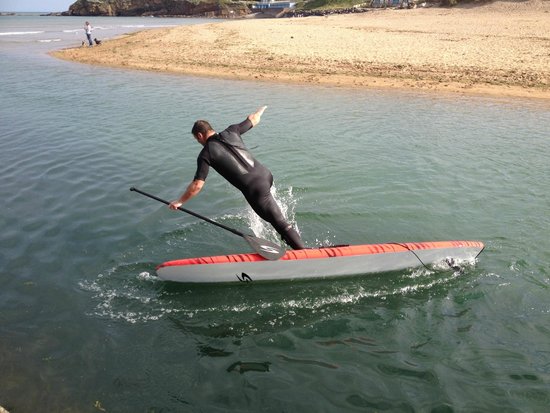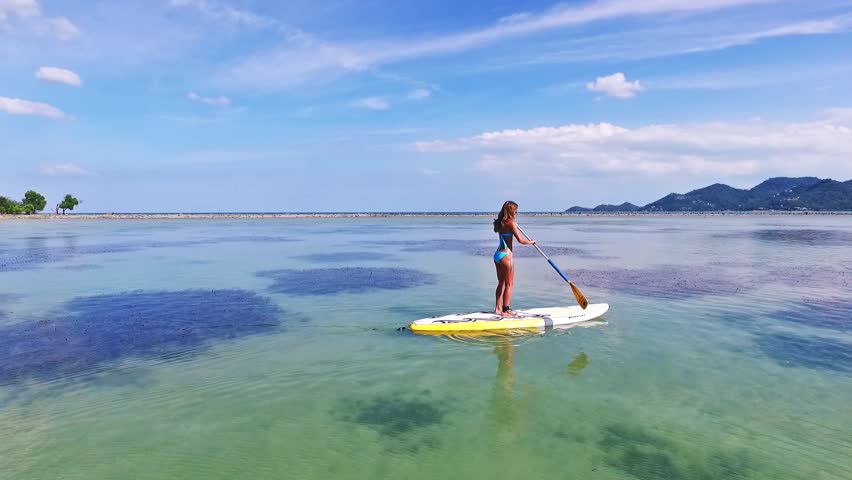Table of Contents
- 10 Things Not to Do As a Stand Up Paddle Board Beginner
- Here Are 10 Things NOT to Do if You’re a Stand Up Paddle Board Beginner:
- 1. Using Your Arms to Pull the Paddle
- 2. Paddle Boarding in Congested Areas
- 3. Standing Too Far on the Board
- 4. Not Gripping the Top of the Paddle
- 5. Not Checking the Weather Forecast
- 6. Keeping Your Arms Very Close Together
- 7. Paddling at an Angle
- 8. Paddle Blade Faces the Wrong Way
- 9. Not Putting the Paddle in the Water
- 10. Looking Down at Your Feet
10 Things Not to Do As a Stand Up Paddle Board Beginner
 Are you a stand up paddle board beginner and are thinking about taking it up? Stand Up Paddle boarding (SUP) is different from traditional surfing and as the name suggests involves standing up on a board and paddling.
Are you a stand up paddle board beginner and are thinking about taking it up? Stand Up Paddle boarding (SUP) is different from traditional surfing and as the name suggests involves standing up on a board and paddling.
In an earlier blog post. We talked about getting started with standup paddle boarding and how to choose a SUP board as a beginner.
Now we will go into the 10 things you should not do if you are a newbie to standup paddleboarding.
Here Are 10 Things NOT to Do if You’re a Stand Up Paddle Board Beginner:
1. Using Your Arms to Pull the Paddle
It might seem natural to use your arms to paddle. However, keep in mind your core is stronger than your arms. The result is you’ll get more powerful paddling and thus move faster.
Here’s how you do it. Stand up on the board and bend your knees slightly. Look at the horizon so it will be easier to balance yourself.
You should avoid trying to pull your paddle through the water. Instead, push down and pull back. Focus on pulling your body past the paddle instead of just pulling it through the water.
2. Paddle Boarding in Congested Areas
Paddling in congested areas especially if you are a newbie can cause you to get nervous and wipe out. You can avoid this situation by going to places that aren’t crowded with many people paddling. This is conventional wisdom but it’s something that people, unfortunately, do anyway.
Make sure to avoid hot spots that are popular for SUP. You should instead paddle where you can enjoy good waves but avoid crowds. It will be a bit tough to find both but it’s definitely worth the time and effort.
3. Standing Too Far on the Board
Make sure you don’t stand/kneel too far forward on the SUP. Here’s why. The fin(s) at the board’s tail functions as a rudder and allows the board to move straight or turn.
When you stand too far forward the fins are out of the water so it’s harder to control the board. You can also fall off the board. You can test if you’re standing too far by checking the carry handle in the middle. If the handle isn’t visible when you’re standing then you are probably too far forward. It’s time to step back so you’re in a better position to stay on the board and manuever it.
4. Not Gripping the Top of the Paddle
Regardless of which side of the board you paddle on make sure your hand grips the top portion of the paddle. First, the hand at the top should be on the opposite side of the board you’re paddling on.
This provides the best leverage and control when using the paddle. That’s because it functions as a lever. If you fail to grip the top of the paddle it results in less leverage and you don’t advance the board efficiently.
5. Not Checking the Weather Forecast
There’s nothing 100% in life and that includes the weather forecast for the day you’ll go paddle boarding. However, today’s technology has made weather reports more accurate than ever. Make sure to get the weather forecast for destinations if they’re 1+ hours away.
There are a few reasons you should take this step. It’s important to avoid heavy rains, strong winds, and other weather conditions that could make it tough to operate a stand-up paddleboard. Another indirect factor is strong winds could cause choppy waters. If you are a beginner you definitely want to avoid these conditions because it is not optimal for learning and you could risk not enjoying the experience.
6. Keeping Your Arms Very Close Together
The problem with this action is you won’t get enough leverage. It results in using your arms instead of your core, back, and legs.
This might seem like a small issue but it’s basic physics. For example, consider the size of your legs compared to the size of your arms. Using your back and core muscles offers more power to boost your force and momentum. There’s a reason you should lift with your back instead of your arms.
7. Paddling at an Angle
When you learn how to do paddle boarding the first maneuver you learn is the forward stroke. As easy as it might seem, many beginners get this technique wrong.
The mistake they often make is not paddling vertically in the water before they start the forward stroke. They instead bend their elbow and the blade moves at an angle.
This results in the board turning instead of moving straight. Make sure the paddle is straight from top to bottom instead of at an angle when you place it in the water. You should also extend the top arm across the chest to make the paddle/blade vertical.
8. Paddle Blade Faces the Wrong Way
This mistake is quite common among newbie SUPers. It’s common to pick up a paddle and hold it so the blade’s angle slopes towards them. The paddle looks like it should scoop water but taking this step actually slows you down since the water is pulled up and you’re slowed down by drag.
Make sure to bend the paddle’s blade away from you. This provides benefits in terms of speed and tracking by creating lift. If you’re using ISLE paddles make sure the logo on the unit is facing forward.
9. Not Putting the Paddle in the Water
OK, it’s safe to say you won’t get too far if you don’t put any of part of the paddle into the water. We’re talking about putting half the paddle in the water. When you stroke this will result in more splashing than moving and that’s a bad thing.
When you stroke the paddle make sure to place the unit in the water fully and smoothly. This not only will help to reduce the amount of splashing but also the noise you make when paddling. These are both results you’ll want to minimize when doing SUP.
10. Looking Down at Your Feet
While paddling makes sure to avoid looking down as you paddle. It might seem natural because you want to maintain your balance and you’re in a less stable position than sitting down in a canoe, for example. The problem is the opposite will likely happen—you’ll fall off the board!
When paddling the board, you should look at other things besides your feet. That includes something in the water or on the shore. Then start paddling towards the object as you keep your eyes on it.
Hopefully you can use these tips when you go out stand up paddle boarding. Let us know what you think about these tips after your next paddle board outing!



